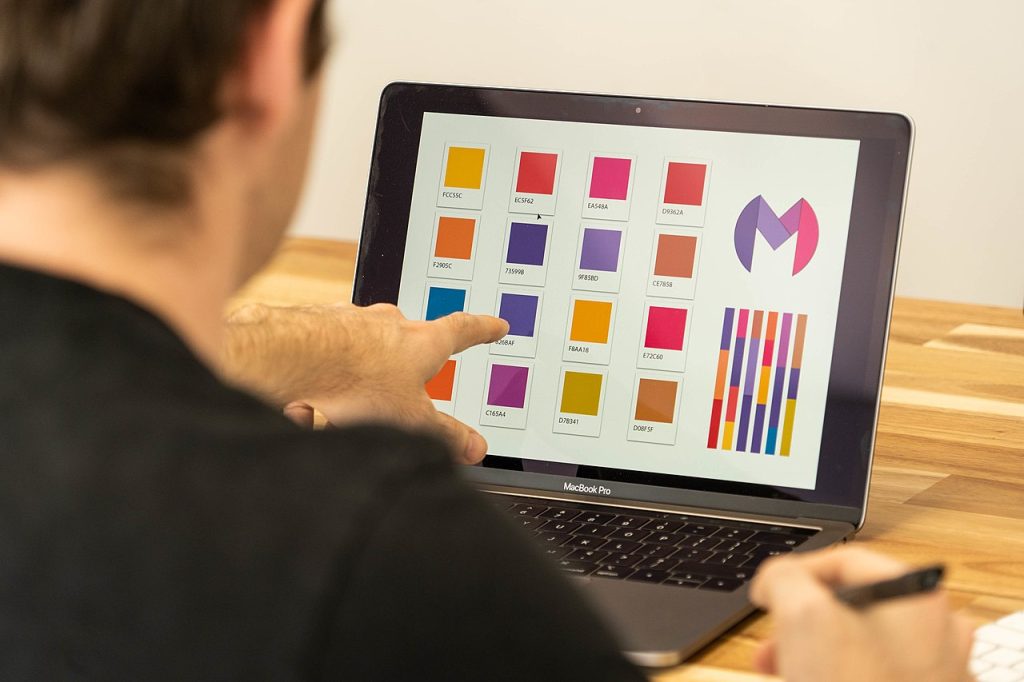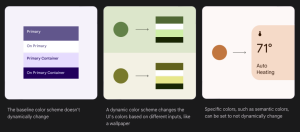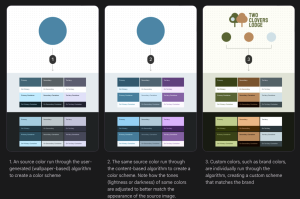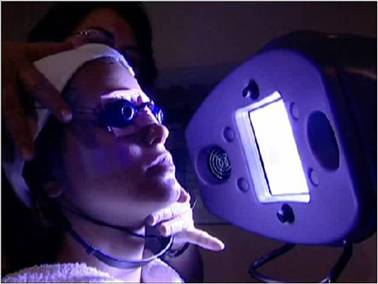Colour psychology and physiology
Colour Theory: History and Culture
It is generally accepted that colour can affect our emotions and mood. Different colours have been identified as triggering certain emotional or physical reactions. Colours can have both positive and negative associations and these can vary for each person.
Are emotional links to colour universal?
Recent studies investigating emotional links to colour have found that although our perceptions and uses of colour can be specific to different cultural groups, some links are shared universally[1].
This page provides some background into theories of colour and its effect on human psychology and physiology. Topics covered:
Colour associations
You might have your own colour associations like these listed in Table 1.1 – can you think of any more emotions or states to add to these colours that have meaning for you?
| Red
heat, activity, anger, danger, passion, energy |
Yellow
happiness, warmth, positivity, cheerfulness, compassion |
Blue
cold/coolness, stability, loyalty, seriousness, envy, trust, peace |
| Purple
wisdom, power, imagination, spirituality, royalty, sophistication, mystery |
Orange
warning, warmth, fun, youth, optimism, excitement
|
Green
calm, serenity, relaxation, renewal, envy, wealth, abundance |
| Pink
love, affection, romance, softness, kindness, sweetness
|
Gold
wealth, fortune, luxury, triumph, royalty, abundance, glamour
|
Brown
practicality, honesty, simplicity, dependability, trustworthiness |
| White
purity, cleanliness, innocence, perfection, spirituality
|
Black
elegance, drama, power, death, evil
|
Grey
stability, authority, maturity, modernity, the mundane, sadness, boredom |
View this infographic on the Information is Beautiful website for more colour associations.
Colour in advertising and logo design

Many studies and articles you will find online about how colours affect our emotions and mood are anecdotal – that means they are not based on reliable research or factual evidence. However, there is significant evidence in marketing research that colour plays an important role in what we buy and how we are attracted to different products.
For example, it’s no coincidence that popular fast-food companies like McDonald’s or Hungry Jack’s have red and yellow logos and packaging designs – these colours are said to stimulate appetite.
Other well-known colours in advertising include Coca-Cola red, Facebook blue, Cadbury purple, Fanta orange, Android green, and Barbie pink. These colours have become iconic in contemporary culture, and it is easy to associate the colour with the product. See Figure 1.20 for some examples of well-known logo designs arranged by colour. Do you notice any patterns? Do certain types of businesses prefer certain colours?
Learn more about the psychology of colour in marketing.
Logo design
Colour in logo design can be used to communicate meaning about a particular brand or product and what an organisation/individual represents or how they want their customers to perceive them. Some logos may have different colour versions depending on usage, many iconic logos use consistent colour and have strict rules about usage. For example, have you ever seen a green Coca-Cola can with pink text? Probably not!
If you are designing a logo for yourself or a client, you may need to create a style guide or brand guide which is a way of controlling and communicating how your logo and other graphics must be used. Colour information is very important in a style guide. You should include information about the colours that can be used in the logo and background, how much space should be around the logo, the relative size and scale of the logo, and where it can be positioned on printed or screen media.
For example, Google’s Material Design colour system (Figures 1.21 and 1.22) give very clear instructions for the correct ways to develop colour schemes and palettes that work with branding to create well-designed and accessible interfaces for screen devices.


Learn more about colour and logos from these online resources:
- Color psychology: the logo color tricks used by top companies
- Exciting red and competent blue – the importance of color in marketing
- The colour emotion guide
- Psychology of colour in logo design
Colour, psychology and art therapy
Colour, personality and pseudoscience
Colour has also historically been linked to human psychological traits and personality types, although these theories are now outdated and have no basis in current psychology. One of the better-known examples of this is from the work of Carl Jung who was a Swiss psychiatrist and psychoanalyst in the early 20th century. He is quoted as saying “colours are the mother tongue of the subconscious” and “colours express the main psychic functions of man”.
Although greatly influenced by Sigmund Freud (the founder of Psychoanalysis), Jung did not agree with all of Freud’s theories. He founded Analytical Psychology in 1913 after breaking with Freud. One of Jung’s theories was the classification of psychological personality types linked to four colours: red, blue, green and yellow. These colours were placed in a grid with X and Y axes.
- X represents the line between Introversion and Extroversion,
- Y represents the line between Thinking and Feeling.
This theoretical way of determining a person’s psychological type is now dismissed by today’s psychologists as it’s not based on any proven evidence of how our brains work. Personality is far more complex than Jung’s limited classification system can describe – which Jung also acknowledged himself.
However, Jung’s book Psychological Types (1921) was further developed in the 1940s by Katherine Cook Briggs and her daughter Isabel Briggs Myer (neither had formal training in psychology) into the Myers-Briggs 16 personality types, which also has colour associations and is a popular personality test that is still used today. It is important to note that there is no evidence that the Myers-Briggs personality test is an accurate or useful tool for determining a person’s personality, or success in career or life choices.
Art Therapy
Where Jung’s theories about colour and creativity have found greater practical use is in the emergence of art therapy as a field of practice that helps people deal with trauma and illness through creative work. Colour can be used effectively in art therapy as part of a process of expressing troublesome thoughts and feelings in a visual way.
Learn more from these online resources:
- What color psychology really means
- What is Art Therapy?
- Hogan, Susan. Healing arts : the history of art therapy, London: Jessica Kingsley, 2001.
- Hogan, Susan ed. Feminist Approaches to Art Therapy, Routledge 1997
- More publications by Susan Hogan on Art Therapy
- Why the Myers-Briggs test is totally meaningless
Colour and medical therapy
Chromotherapy – therapy or quackery?
Light and colour have been used in many attempts at healing therapy since ancient times. There is evidence from Ancient Egypt, Greece and India of sunlight, coloured light and coloured materials claimed to be used for healing. The Persian scholar and philosopher Ib Sina (Avicenna)(c. 970–1037 CE) also promoted the idea of using colour for healing.
These practices formed the basis for later theories of chromotherapy by practitioners such as American physician Edwin D. Babbitt who developed a range of light therapies including a thermolume – a cabinet that was able to project coloured light onto various parts of the body. He also ‘irradiated’ water with sunlight filtered through coloured lenses. Dinshah Ghadiali was another inventor who claimed that colour therapy was the key to health. He invented a box with a 1000-watt light and coloured filters called a Spectro-Chrome which he claimed was able to produce twelve different colours to be used for different therapeutic purposes. He was labelled a fraud by the medical establishment of the day.

Phototherapy today
Despite the debunking of these claimed ‘alternative’ therapies, there has been a recent rise in light therapy with the use of coloured LED lights for treatment of skin conditions such as acne or aging skin (Figure 1.23). The theory is that certain wavelengths of colour can promote healing and skin regeneration. Research in this area is recent and largely inconclusive. There are also concerns that incorrect use of these devices which have strong LED lights, may cause eye damage.
There is a type of evidence-based light therapy (phototherapy) for babies that may have Newborn Jaundice (Hyperbilirubinemia). These newborns are placed under a blue light (420–470 nm wavelengths) to treat the condition (Figure 1.24). The blue light helps to remove bilirubin from the blood. This kind of phototherapy has been used for many decades.

Learn more from these online publications:
- Edwin D Babbitt, The Principals of Light and Colour 1878, Babbitt and Co.
- Quackwatch.org “Colourful Nonsense: Dinshah Gladioli and his Spectro-Chrome Device”
- Harvard Health Publishing, Harvard Medical School, 2019, “LED lights: are they a cure for your skin woes?”
- Mohr, C., & Jonauskaite, D. (2022, February 8). Why links between colors and emotions may be universal ... And the enduring debate over the meaning of red [Journal]. Psychology Today. https://www.psychologytoday.com/au/blog/color-psychology/202202/why-links-between-colors-and-emotions-may-be-universal ↵

